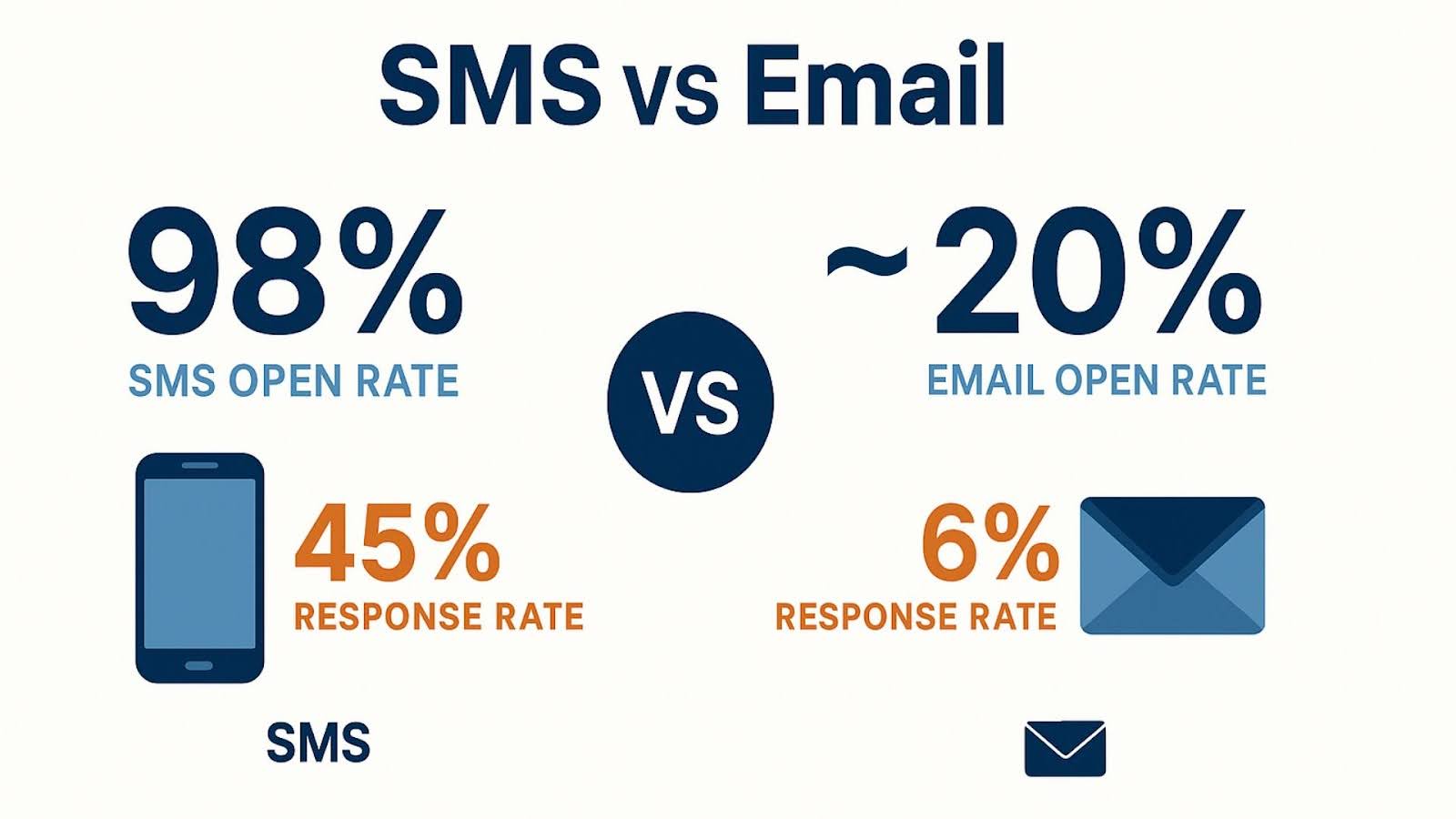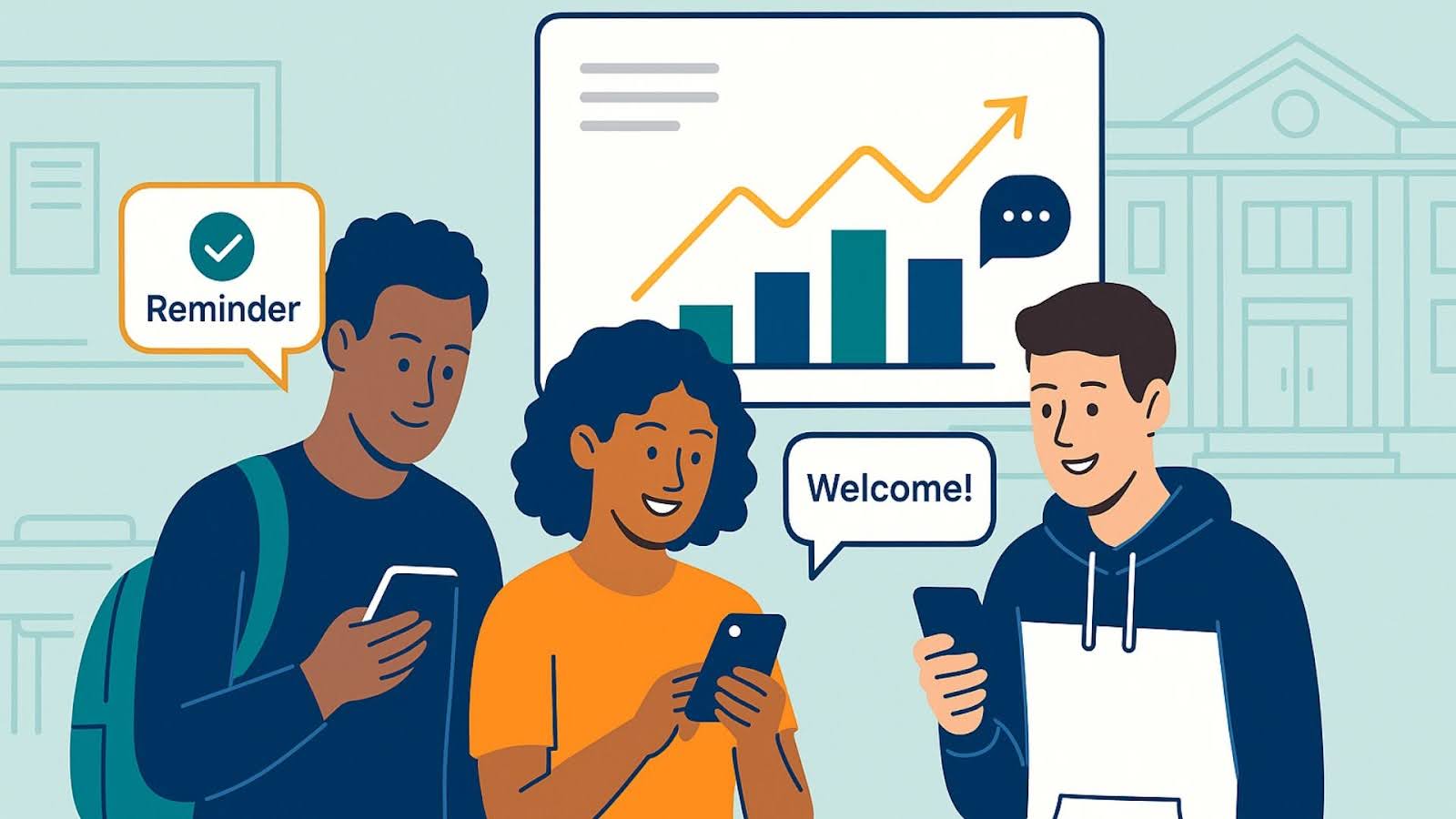Best Texting Platforms for Higher Ed Communication: Guide to SMS for Colleges
SMS messaging delivers high open rates compared to email, making it the most powerful communication channel for reaching college students.
- Text messages generate higher response rates, creating unprecedented opportunities for meaningful student engagement.
- Higher education requires specialized SMS platforms with FERPA compliance, Student Information System integration and academic lifecycle automation rather than generic business texting tools.
- Essential platform features include two-way conversational messaging, sophisticated audience segmentation, comprehensive analytics and automated workflow capabilities.
- Successful implementation demands cross-campus collaboration, pilot program testing and focus on value-driven communication that supports student success.
Institutions that master SMS communication gain a decisive advantage in student attraction, engagement and retention as traditional communication channels continue to fail.
Higher education communication has reached a breaking point. Students routinely ignore emails and screen calls, while traditional outreach methods fail to connect when it matters most. Meanwhile, college students spend significant time on their smartphones daily, creating an obvious disconnect between how institutions communicate and how students actually consume information.
The solution is meeting students where they already are. SMS for colleges provides an avenue for institutions that want to engage students, from initial inquiry through graduation and beyond.
While email open rates hover around 25%, text messages achieve a 98% open rate. Even more impressive, 45% of people respond to text message campaigns compared to just 6% who respond to emails. For institutions struggling with student engagement, enrollment management or retention challenges, these numbers represent a transformative opportunity.
However, not all texting platforms provide the same value, especially for the unique needs of higher education institutions. Generic business SMS tools lack the sophisticated features, compliance capabilities and integration requirements that colleges and universities demand.
What Makes SMS for Colleges the Best Platform for Higher Education?
The distinction between business texting tools and higher education messaging platforms goes beyond basic SMS functionality. Academic institutions require specialized solutions designed for the complexity of student lifecycles, regulatory compliance and diverse campus constituencies.

Higher Education-Specific Requirements
Student privacy regulations are the first major differentiator. FERPA compliance is mandatory. The best platforms for colleges include built-in safeguards that protect sensitive student information while enabling effective communication. Your SMS strategy must include encrypted data transmission, secure integrations with Student Information Systems (SIS) and proper consent management workflows.
Campus populations also require more sophisticated segmentation than typical users. Students need to be grouped by academic status, major, graduation year, housing situation, financial aid status and dozens of other variables that don't exist in standard business contexts. The platform must handle this complexity seamlessly while maintaining personalization at scale.
Integration Capabilities That Matter
The most effective student texting tools integrate seamlessly with existing campus systems, such as your Customer Relationship Management (CRM), SIS, learning management system and other critical infrastructure. This integration enables automated workflows that respond to student actions, academic milestones or administrative triggers without manual intervention.
Essential Features Every College SMS Platform Must Have
When evaluating higher ed messaging software, certain features separate professional-grade platforms from basic texting tools. These capabilities determine whether your SMS program enhances student success or simply adds to communication noise.

Two-Way Conversational Messaging
Broadcasting messages lives in the most basic level of SMS. True student engagement happens through conversation. Students should be able to reply to messages, ask questions and receive personalized responses that address their specific needs.
The best platforms blend automation with human oversight, allowing staff to jump into conversations when complex issues arise while automatically handling routine inquiries. This hybrid approach ensures students get immediate responses to simple questions while receiving personalized attention for more complex situations.
Advanced Automation and Scheduling
Student communication requires precise timing. A registration reminder sent too early gets forgotten; sent too late and it's useless. Effective platforms allow you to create messaging workflows that trigger texts based on specific student actions, dates or system changes.
Comprehensive Analytics and Reporting
Understanding what works in the real world requires detailed analytics. Look for platforms that provide insights into conversation quality, response sentiment and correlation with key institutional outcomes like retention rates or enrollment completion.
The most valuable analytics tie messaging performance to broader institutional goals. Can you demonstrate that students who engage with your text messaging program have higher GPAs or better retention rates? That's the kind of data that justifies and expands SMS investments.
Audience Segmentation and Personalization
Generic messages generate generic responses. Communication software for universities must enable sophisticated audience segmentation beyond basic demographics. The ability to create dynamic groups based on academic progress, engagement levels or specific behaviors allows for highly targeted messaging that resonates with each student's unique situation.
Personalization in higher ed requires more than inserting first names. The best platforms can reference a student's major, upcoming deadlines, campus involvement or other relevant details that make each message feel individually tailored rather than mass-produced.
What Types of Higher Education Texting Platforms Exist?
Understanding available solutions helps institutions choose the right fit for their needs and existing tech infrastructure.
All-in-One Higher Education Platforms
These comprehensive solutions are built specifically for academic institutions and typically include SMS as part of broader student engagement suites. They offer deep integration with campus systems, sophisticated automation capabilities and features designed for the student lifecycle.
Key Advantage: Having all communication tools unified under one platform with consistent data and seamless workflows.
Key Challenge: Full-scale solutions often require larger investments and longer implementation timelines.
CRM-Integrated SMS Solutions
Many institutions already invest in CRM platforms for recruitment and student management. CRM-integrated SMS tools extend existing workflows by adding texting capabilities directly within familiar interfaces.
Key Advantage: Ideal for teams that already rely on their CRM, these tools add SMS capabilities without disrupting existing workflows and keep all student communications centralized, regardless of channel.
Key Challenge: Implementation and customization can be complex, often requiring IT involvement or vendor support to ensure the SMS functionality aligns with your institution’s specific CRM setup.
Specialized SMS-First Platforms
Some platforms focus primarily on text messaging functionality while offering integrations with other systems. These solutions often provide the most advanced SMS features and flexibility but may require additional tools for comprehensive student communication strategies.
Key Advantage: SMS-first platforms typically offer more sophisticated messaging capabilities, including advanced automation, AI-powered responses and detailed analytics.
Key Challenge: They may require more advanced technical expertise to integrate effectively with existing campus systems.
How Should You Evaluate SMS Platforms for Your Institution?
When choosing the right platform, consider both immediate needs and long-term goals. Your evaluation should involve multiple campus stakeholders and focus on measurable outcomes rather than feature lists.
Start with Use Case Definition
Before comparing platforms, clearly define how you'll use SMS for colleges across different departments and student populations. Consider your primary focus:
- Recruitment and admissions
- Student retention and success
- Emergency communications
- Alumni engagement
Different use cases may favor different platform strengths.
Map out your current communication challenges and identify where SMS could have the most impact. This foundation helps you evaluate whether specific platform features align with your actual needs rather than theoretical nice-to-haves.
Technical Integration Requirements
Inventory your existing technology stack and determine integration requirements. Which systems must connect with your SMS platform? What data needs to flow between systems? How will you maintain data consistency?
The most feature-rich SMS for colleges becomes useless if it can't integrate with your current infrastructure. Prioritize platforms that offer robust APIs, pre-built integrations and reliable data synchronization.
Compliance and Security Standards
Student data protection isn't negotiable. Evaluate each platform's approach to FERPA compliance, data encryption, user access controls and audit capabilities.
Also, consider the Telephone Consumer Protection Act (TCPA) requirements for obtaining proper consent before sending messages. The platform should provide tools for managing opt-ins, opt-outs and consent documentation to ensure your program remains compliant.
5 Critical Questions to Ask SMS Platform Vendors
When speaking with potential vendors, these questions will help you evaluate whether their solution can meet your institution's needs and long-term goals.
1. How Does Your Platform Handle Student Privacy and FERPA Compliance?
Ask for specific examples of how the platform ensures FERPA compliance, including data encryption, access controls and integration safeguards. Request documentation of their compliance certifications and security audit results.
Understanding their approach to consent management is equally important. How do they handle opt-in requirements? What tools do they provide for managing student preferences and ensuring TCPA compliance?
2. What Integration Capabilities Do You Offer with Campus Systems?
Generic integrations aren't sufficient for higher education's complex tech environments. Ask for specific examples of integrations with SISs, CRMs and learning management platforms used by similar institutions.
Ensure you understand both the technical capabilities and the support provided during implementation. Do they offer pre-built connectors for your existing systems? What level of technical support is available during the integration process?
3. How Do You Support Conversational Messaging at Scale?
Broadcasting messages is easy; managing thousands of individual conversations is complex. Ask how their platform handles reply management, conversation routing and the blend between automated and human responses.
Request examples of conversation workflows and understand how messages are prioritized and assigned to appropriate staff members. Can the system identify when a conversation requires human intervention versus automated response?
4. What Analytics and Reporting Capabilities Do You Provide?
Basic engagement metrics aren't sufficient for demonstrating ROI and improving program effectiveness. Ask for examples of each vendor’s reporting dashboards and the specific metrics they track.
Understand how they measure conversation quality, sentiment analysis and correlation with institutional outcomes. Can you track whether students who engage with SMS programs have better retention rates or academic performance?
5. What Does Your Pricing Structure Look Like for Our Institution Size?
SMS pricing models vary, from per-message costs to monthly subscription fees. Understand not just current pricing but how costs will scale as your program grows, and how additional features or integrations might affect pricing.
Ask for examples of the total cost of ownership for similar institutions, including implementation fees, training expenses and ongoing support. Avoid hidden costs as they can impact your program's long-term sustainability.
Implementation Best Practices for College SMS Programs
Successfully launching SMS for colleges requires careful planning, stakeholder buy-in and systematic execution. Even the best platform will fail without a proper implementation strategy and ongoing management.
Build Cross-Campus Support
SMS programs affect multiple departments, from admissions and student affairs to IT and compliance. Establish a cross-functional team that includes representatives from all affected areas to ensure comprehensive planning and smooth execution.
Create clear governance policies that define:
- Who can send messages
- What types of messages are appropriate
- How to maintain a consistent brand voice across different departments
- Approval workflows for new messaging campaigns
- Regular review processes to ensure quality control
Start with Pilot Programs
Rather than launching institution-wide immediately, begin with targeted pilot programs that allow you to test messaging strategies, refine processes and demonstrate value. Choose pilot audiences that are likely to engage positively and can provide meaningful feedback.
Document everything during the pilot phase, including what messages generate the highest response rates, when students are most likely to engage and what types of questions come up frequently. This data will become invaluable for scaling your program.

Focus on Value-Add Communication
Students will quickly tune out messages that don't provide genuine value. Every text should serve a specific purpose:
- Providing useful information
- Answering questions
- Solving problems
- Connecting students with resources they need
Avoid using SMS to share information that's easily available elsewhere or messages that feel more like marketing than support. The goal is to position texting as a helpful resource that makes students' lives easier, not another communication channel they need to manage.
How Do You Measure SMS Platform Success in Higher Education?
Measuring the success of your SMS program requires tracking engagement metrics and institutional outcomes. The most effective measurement strategies combine quantitative data with qualitative feedback to provide a comprehensive view of program impact.
Key Performance Indicators
Response rates provide immediate feedback on message relevance and timing. Track not just overall response rates but also response patterns across different message types, student populations and timing strategies. This data helps you optimize future communications for maximum engagement.
Retention metrics offer the most meaningful measure of SMS program success. Institutions implementing SMS programs report meaningful improvements in student persistence and engagement rates. These boosts become particularly valuable when you consider that retaining even a small percentage of additional students can generate significant revenue increases.
Conversion metrics track how well SMS drives desired actions, such as:
- Completing enrollment steps
- Attending events
- Accessing support services
- Responding to surveys
These measurements demonstrate direct ROI and help justify continued investment in SMS for colleges.

Long-term Impact Assessment
The most compelling success metrics connect SMS engagement with broader institutional goals. Students who actively engage with text messaging programs often demonstrate higher GPAs, better course completion rates and stronger connections to campus resources.
Track these correlations over multiple semesters to understand the long-term impact of SMS communication on student success. This data becomes powerful for securing additional resources and expanding program scope.
Frequently Asked Questions
What's the difference between SMS platforms designed for higher education versus general business use?
Higher education platforms include specialized features like FERPA compliance, integration with Student Information Systems, sophisticated audience segmentation based on academic factors and messaging workflows designed for the student lifecycle. General business platforms lack these education-specific capabilities and compliance features.
How much should institutions expect to spend on SMS platforms?
Costs vary based on message volume, platform features and integration requirements. Most institutions see costs ranging from a few hundred to several thousand dollars monthly, depending on their size and needs. However, the ROI from improved retention and enrollment outcomes typically justifies these investments.
What compliance requirements must colleges consider when implementing SMS programs?
Primary requirements include TCPA compliance for obtaining proper consent before sending messages, FERPA compliance for protecting student educational records and state privacy laws. Platforms should provide tools for managing opt-ins, opt-outs and consent documentation.
Can SMS platforms integrate with existing campus technology?
Most higher education SMS platforms offer integrations with common campus systems, including Student Information Systems, CRM platforms, learning management systems and email marketing tools. The depth of integration varies by platform, so evaluate specific connectivity requirements during vendor selection.
Level Up Your Campus Communication Strategy
The shift toward SMS communication in higher education is a necessary evolution that meets students where they already spend their time and attention. With high open rates and immediate response capabilities, text messaging offers institutions an opportunity to improve student engagement, boost retention and streamline campus communication.
However, success requires more than simply choosing any SMS platform. The unique requirements of higher education demand specialized solutions built specifically for academic institutions. The investment in the right SMS platform pays dividends through improved student outcomes, more efficient operations and stronger institutional connections with learners.
As competition for student retention intensifies and engagement expectations continue rising, institutions that master SMS communication will have a significant advantage in attracting and retaining lifelong learners.
Request a demo to discover how Modern Campus can help your institution leverage the power of conversational SMS messaging to drive student success and engagement across the entire learner-to-earner lifecycle.
Last updated: October 23, 2025



